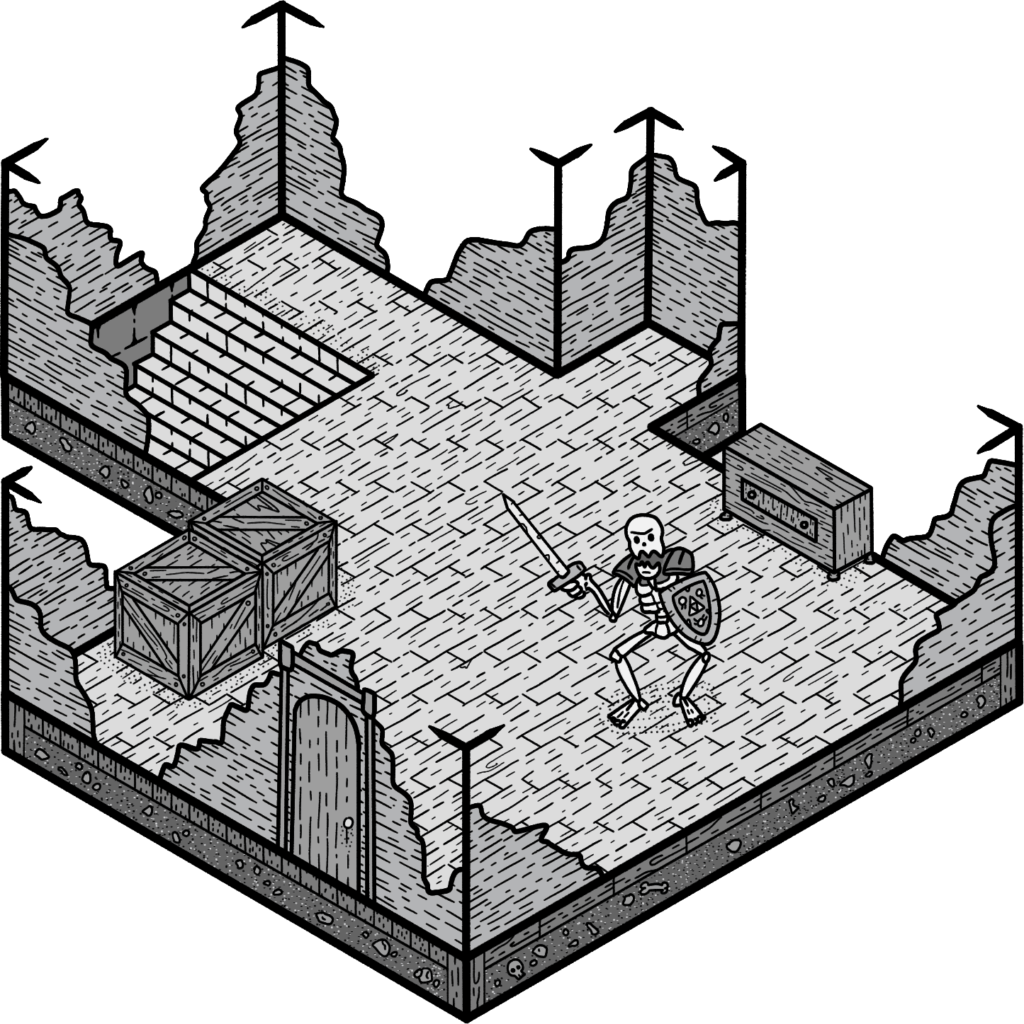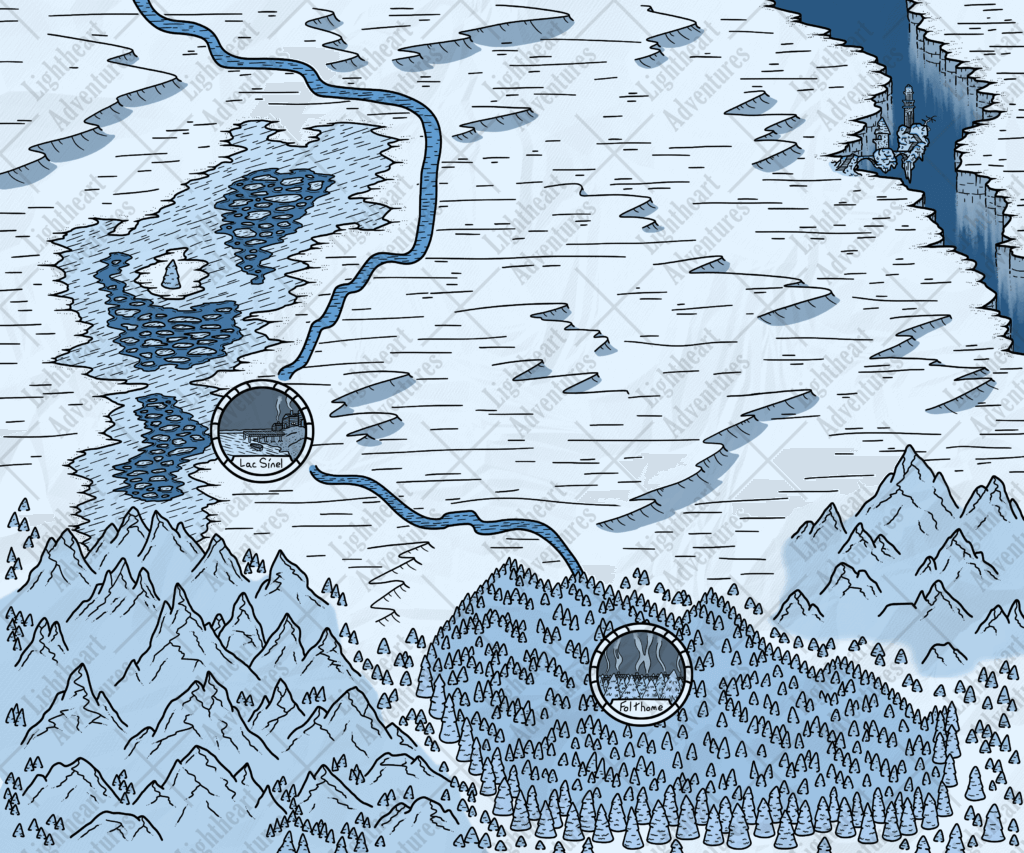Welcome back to our New DM’s Guide to Everything series! Previously, we talked about worldbuilding and fleshing out your landscape with details. This week, we’re going to dive into how to design TTRPG encounters!
What makes a really good encounter? Is it swarms of teeming goblins looking for blood? Maybe some trap-laden dungeons with fireball-flinging mages? How about an intense showdown with a disguised lich during a cordial banquet? In my opinion, the best and most memorable encounters are ones that challenge players, move the plot forward, and are more than just straight-out fights. In today’s post, I’ll go into the intricacies of designing TTRPG encounters!
Be sure to check out our other DM’s Guide to Everything posts:
Disclaimer: This post includes affiliate links, which means that if you choose to purchase something after clicking on one of the links, we may receive a small commission, at no additional cost to you. As Amazon affiliates, we may earn from qualifying purchases. Thanks for supporting your favorite dungeon artists!
Types of Encounters
Reinforcements
So what exactly is an encounter in a table top roleplaying game? Encounters are in-game scenes that require player participation to resolve. This ranges from sneaking into a baron’s estate, fighting a beholder in its lair, to disarming an exploding fireball trap. Any time you allow players to act, you’ve created an encounter. Most types of encounters in TTRPGs tend to be combat-focused, but asking adventurers to navigate a treacherous cliff face to reach a dungeon can be just as nail-biting. Remember that encounters should never impede progress if the players can’t beat it, but should instead offer multiple avenues of success or failure.

How to Design TTRPG encounters with balance
It’s tough to find the right balance between nail-bitingly difficult fights and pushovers. Not every fight needs to be a life-or-death situation, as sometimes it makes sense for the adventurers to only have to take out 1-2 guards instead of an entire patrol. However, the important encounters should require the party to think about their actions instead of attacking on auto-pilot.
Math...
Games like D&D have a mathematical formula for how it generates challenge ratings (CR) for the monsters in game. This type of math is a helpful starting point for an idea on how to balance an encounter, but it shouldn’t be the only factor. In theory, a CR 1 bugbear is a “medium” challenge for four 1st-level adventurers. In practice, a four versus one fight boils down to the party ganging up on the bugbear with minimal expenditure of resources (like health and spells). However, a CR 1 copper dragon wyrmling not only has a breath weapon which can hit multiple adventurers, but flies as well, meaning the same CR fight could be significantly harder for a party to deal with.
...versus Experience
Finding the right amount to challenge your player requires familiarity with both your player’s abilities and that of the monsters. This means that some homework is necessary to research the monsters that you plan to introduce into your game. I’ve picked random monsters based on their CR, dropped them into a fight, and watched sheepishly as they were utterly annihilated because I was not familiar with their capabilities. If you need help figuring out how to implement monsters within encounters, I recommend The Monsters Know What They’re Doing by Keith Ammann. He explains how to utilize monsters based on their skills, abilities and attacks, even going so far as to examine stats in relation to tactics the creatures would use to gain the upper hand. That CR 1 bugbear could suddenly attack at night and use its surprise attack ability for maximum damage.
Balancing on the fly
But what happens if you misjudge a balanced encounter half-way through? Well, you risk either causing horrendous casualties among the party, or create an easier fight that upends your storyline. Most long-time DMs have stories about how the party beat a big bad boss long before they were ever supposed to due to miscalculation. On the flip side, perhaps the party wasn’t ready to fight the ancient red dragon in its lair, and it’s likely they’ll have to make new characters if something drastic doesn’t happen. These are a few tricks you can employ to ease the strain of unbalanced encounters:
Fudge Rolls
I say this in all sincerity: fudging rolls takes away from player agency and frequent occurrences inhibit the spirit of role play. On the other hand, rolling a natural 20 that would unintentionally eradicate the party with no escape is pretty harsh. Changing the outcome of a dice roll or card flip isn’t an easy decision, and should only done under dire circumstances. If I ever need to fudge a roll, I’ll do so in the party’s favor, rather than in my own. Often, if the NPC I’ve sent against the party is too strong, I’ll weaken their attacks or reduce hit points to make things more fair.
Reinforcements
If things begin to look grim for your players or the enemies, then send in NPC reinforcements! Bad guys almost always have disposable lackeys hanging around that can make a combat tougher by introducing new enemies. Conversely, if the enemy force is too great, the adventurers’ allies might swing by to provide aid. This could even introduce a new plot thread when the allies need help of their own.
Sudden but inevitable betrayals
Sometimes help comes from the most unexpected place! Instead of an ally coming to help, a lackey who’s sick of the abuse from the bad guy sticks a knife in their back.
In essence, creating the right balance of difficulty and fun comes down to your comfort level as a Game master. The more knowledgeable you are with the game system, the easier it is to push your players when the time comes.
Encounters with Purpose
The adventurers settle down for the first night after riding for miles towards the lich’s lair. The ranger offers to take the first watch, as orcs have been known to raid encampments in the night. Hours later, arrows fly into the camp and battle ensues between orcs and adventurers! Weary, the adventurers travel again the next day, come to a rest, and get attacked by bandits. The next day, they get stopped by a pair of manticore during the ride.
None of these fights have anything to do with the plot of taking out the lich and only serve to pad out game time. There’s nothing wrong with having combat-focused groups, but I find that tying encounters into your plots is a great plan and helps your players stay engaged.
Now let's make it purposeful
Let’s go back to that example adventuring group. Instead of a raiding band of orcs, perhaps they’re attacked by a pack of ghouls led by a wight. While ghouls are useful as as mindless shock troops, the intelligent wight can provide info about the lich if captured. This allows the GM to drop some info about the lich and increase their threat while giving combat-hungry players an outlet. GM’s should take the opportunity to move the story forward whenever possible.
Even pure, random encounters can add some background flavor for future story beats, depending on the amount of pre-planning you’ve done. That group of orcs could be a precursor to another major threat that the lich is attempting to prevent, or the bandits lead lives of crime to provide for their families after fleeing a nearby country. The possibilities are endless!
Consider the Environments

Fights rarely happen in plain, bare rooms or spaces. Even a simple bar brawl has many ways to flavor encounters that can favor the adventurers or their enemies. Here are a few examples to consider when thinking about how to design TTRPG encounters and the environment around your players:
Cover
I’ve talked about cover in the past, specifically that I tend to forget about it in combat situations. However, adding cover like broken walls and crates provides a mechanical boost to armor class (AC), and also drastically changes how players interact with their enemies. In a straight fight between a group of goblins and adventurers, the adventurers would normally win. But if you give those goblins a wooden fortification, now the fight is stacked in favor of the monsters. The adventurers can brute force their attack and try to surpass the goblins’ higher AC, maneuver around the barricade, or even destroy it! You can reward creative players by allowing them to use the barricade for their benefit when goblin reinforcements arrive. It never hurts to consider a battlespace and how players and NPCs could use it to their advantage.


Hazards & Traps
Much like cover, natural hazards and traps can influence party behavior during encounters. I’m of the mindset that I prefer my players know about traps, or at least leave visible clues, and give them more options to deal with it rather than just disarming it. A simple trap I use is a swinging blade on a pendulum, dividing the space between rooms. On its own, the swinging blade isn’t too difficult to evade–maybe just a dexterity save. If the adventures decline to deactivate it, they could lure monsters from deeper within the dungeon and use the blades to their advantage.
Restrictions
Restrictions are in-game limitations to player abilities designed to foster creative thinking during encounters. This can be something like anti-magic fields preventing spellcasting or natural gas pockets that explode if fire is present. These rules are a little more difficult to spontaneously add in since they require more forethought to work within the constraints of your world. As a rule of thumb, I try to create restrictions that don’t immediately punish players or take away from gameplay. Players should be aware of restrictions before an encounter, usually by read-aloud description or from an NPC, so they aren’t blindsided when they’re penalized for failing to adhere to them.
In a recent game of Malifaux: Through the Breach, my players entered a multi-dimensional library to search for info. The librarian informed them of the rules, one of which was “Always be quiet”. During a portion where they had to cross a chasm in the floor, one party member critically failed a skill check and yelped aloud in surprise, drawing the library’s guardians to their location. This kind of restriction requires the players to think critically about any situation that might violate the rule. One player has a teleport spell he normally uses to cross distances, but since magic isn’t quiet, he instead decided to find alternatives to crossing. The group even refrained from using their firearms during the fight in fear of drawing more guardians! Restrictions can be a great method to “shake up” a routine encounter and turn it into one remembered for ages.
Considering how to design TTRPG encounters doesn’t need to be a cause for stress, because you’ll start to see opportunities to make each one special as you begin to create more and as you learn your players’ unique approaches to challenges
Thanks for dropping by! We would love to know how your first gaming session goes, so please drop a comment here on the blog, on Twitter, Facebook, Instagram, or Discord to let us know how it went! If you’d like access to more maps and content, including downloadable PDFs of our adventures, check out our Patreon. We’re able to do what we do because of all our amazing Patrons!







